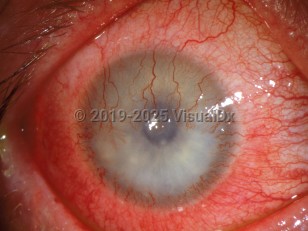Corneal neovascularization - External and Internal Eye
Alerts and Notices
Important News & Links
Synopsis

Neovascularization of the cornea, also called corneal pannus, is the growth of blood vessels from the limbus into the cornea. The blood vessels can be very superficial or deep in the corneal stroma. Corneal pannus is often divided into 2 classes: micropannus, which denotes vascular ingrowth of 2 mm or less and macropannus, which is ingrowth of greater than 2 mm. Neovascularization of the cornea is a nonspecific sign of ocular inflammation. Often, the inflammation is sub-clinical and patients will not be aware of the vascularization, nor will they have any visual complaints. Contact lens wear and eyelid inflammation (blepharitis) are classically associated with asymptomatic pannus formation. More obvious causes of inflammation and corneal neovascularization include corneal ulcers, traumatic corneal scars, and atopic keratoconjunctivitis. Though the blood vessels are nonspecific, they do indicate a chronicity of inflammation as blood vessels do not migrate into the cornea acutely.
Codes
ICD10CM:
H16.409 – Unspecified corneal neovascularization, unspecified eye
SNOMEDCT:
246925003 – Vascularization of cornea
H16.409 – Unspecified corneal neovascularization, unspecified eye
SNOMEDCT:
246925003 – Vascularization of cornea
Look For
Subscription Required
Diagnostic Pearls
Subscription Required
Differential Diagnosis & Pitfalls

To perform a comparison, select diagnoses from the classic differential
Subscription Required
Best Tests
Subscription Required
Management Pearls
Subscription Required
Therapy
Subscription Required
References
Subscription Required
Last Updated:12/21/2008
Corneal neovascularization - External and Internal Eye

